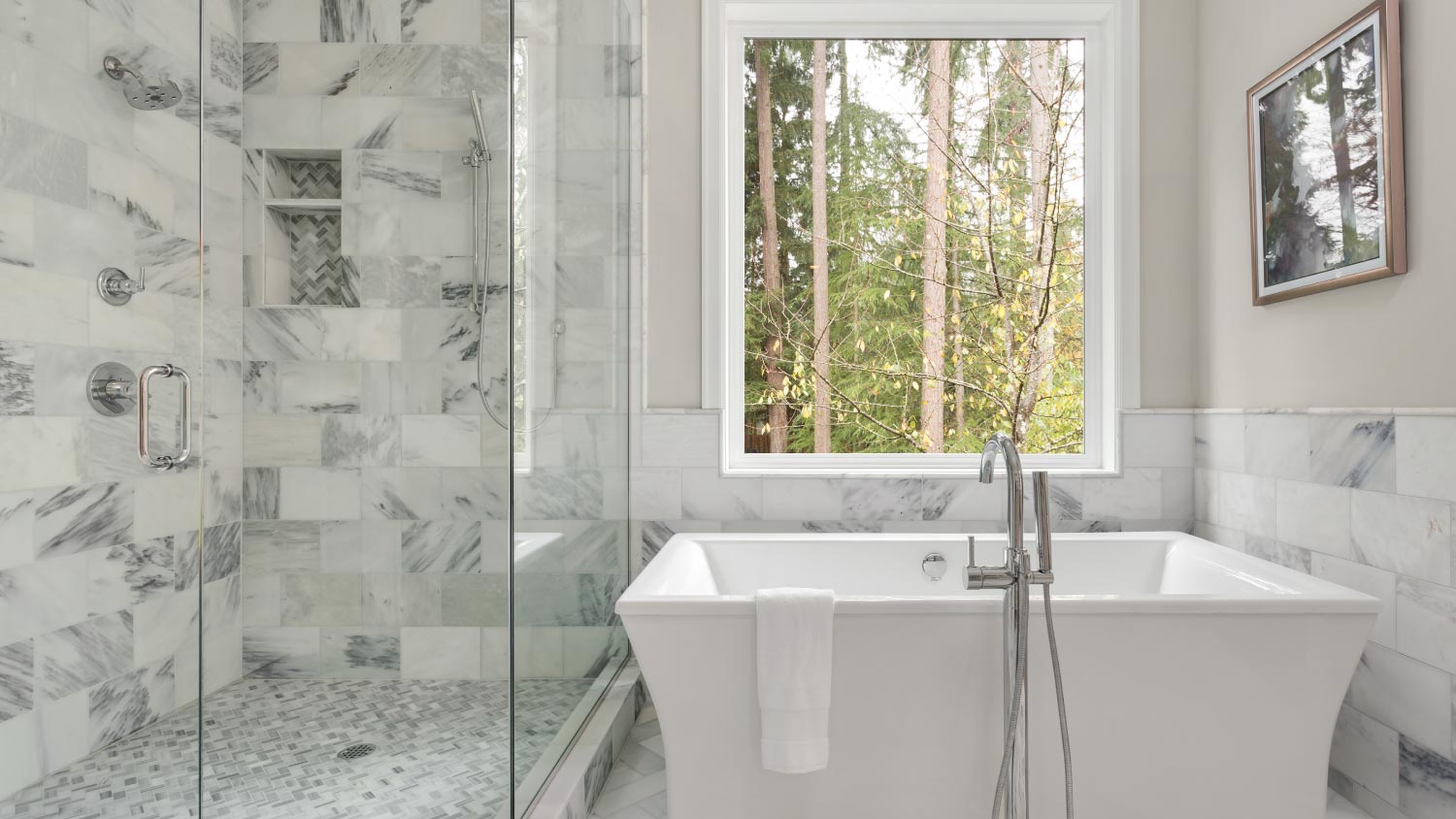
Remodeling your bathroom can add significant value to your home. Your bathroom remodel cost in New York, NY will depend on size, fixtures, materials, labor, and other factors.
A walk-in tub can benefit a large group of people, but weigh the pros and cons first


Walk-in bathtubs offer a comfortable and accessible option for bathing and can increase your home’s value.
These tubs can be more expensive than traditional bathtubs, starting at $4,000.
Deciding whether a walk-in tub is right for you will depend on your personal preferences and accessibility needs.
Walk-in tubs are an excellent way to find comfort while bathing with an easy-to-use door that allows family members with limited mobility to enjoy a soothing soak. But this doesn’t necessarily mean that a walk-in tub is for everyone. Here are the pros and cons of walk-in tubs to consider before purchasing and installing one.
A walk-in tub is a special style of bathtub that features high sides that include a watertight door over a low threshold. The door can be opened and closed before the tub is filled, allowing the user to walk in rather than step over the side of a traditional tub. It will hold the water in the tub, and once the tub is drained, the door can be opened, so the user can step out easily.
A walk-in tub offers many benefits that can make it the right choice for people with limited mobility or those who want a more comfortable experience getting in and out of the tub. A walk-in tub can also include your preferred type of showerhead, allowing more people to benefit from it or allowing you to shower while sitting down.
Walk-in tubs are deeper than traditional tubs to make room for the door. This allows the tub to hold 2 to 4 feet of water, as opposed to the 1 foot of water offered by traditional tubs, which means that you’ll likely be able to submerge more of your body in the water. They often come with a built-in seat, and this seat can even be heated in higher-end models.
One of the most important benefits of a walk-in tub is its increased safety over a traditional bathtub. The low threshold makes it easy to enter and exit, and the seat means you won’t have to fully lower yourself to the bottom of the tub.
Walk-in tubs are especially beneficial for those with mobility concerns and many models are based around the idea of aging in place, making it easier for people to stay in their homes rather than move to an assisted living facility.
Universal design aims to make bathrooms functional and safe for all in the home. Features include grab bars, a comfort height toilet, slip-resistant flooring, a shower seat, a walk-in tub, a curbless shower, and making the bathroom wheelchair accessible.
A warm bath offers many health benefits, and a walk-in tub makes sure these benefits are available to as many people as possible. The warm water can help loosen stiff joints and increase circulation, which helps improve mobility. A walk-in tub helps maintain hygiene even as mobility declines. It can also foster a sense of independence, which can maintain or improve mental health.
The amount that a walk-in tub can increase home value varies, but if the home is located in a neighborhood populated by older adults, was installed as part of a larger bathroom renovation, or is in a home that also includes a traditional bathtub or walk-in shower, it can increase home value when it’s time to sell.
For all of their benefits, walk-in tubs do have some disadvantages, namely that they can be more expensive than a standard tub and that they take a while to fill and drain.
The cost of installing a walk-in tub can be significantly higher than that of a traditional bathtub, with prices reflecting the complexity of the installation and the specific characteristics of the home. Bathtub replacement costs range from $2,000 to $9,400, but walk-in tub costs average from $4,000 to $22,100. However, these costs can be even higher based on your home's unique layout and location.
Factors such as additional plumbing, electrical work, and even local labor rates can cause expenses to rise. If you're a Medicare or Medicare Advantage beneficiary, you might be eligible for financial assistance if the tub is deemed medically necessary, but this is not guaranteed. It's essential to assess your specific situation and consult with a professional to get accurate cost estimates tailored to your needs.
Traditional tubs allow you to fill the water and then immediately step into a hot bath. This obviously isn’t possible with a walk-in tub that must allow the door to open and close. Because of this, you’ll have to get into the tub and then wait for it to fill. At the end of the bath, you’ll have to wait for the water to drain. A heated seat feature can make this wait more comfortable, but it will also add to the total walk-in tub cost.
Walk-in tubs and standalone bathtubs use almost the same amount of water—40 to 50 gallons for a walk-in versus 40 to 80 gallons for a standalone. Where the difference comes in is if you’re transitioning from taking showers to taking baths due to mobility or safety issues. Showers use between 12 and 40 gallons depending on water pressure and the length of the shower, so switching over to a tub versus a shower can significantly increase your water usage.
Walk-in tubs are larger than the standard bathtub size, so installation may require more work than simply removing the old tub and replacing it with a new one. If a walk-in tub is included in your bathroom remodel ideas, it’s important to take the right measurements and evaluate the work needed to install it properly.
When planning a home for aging in place, consider options beyond walk-in tubs. A wet bathroom offers easy access with no barriers, making it safe and spacious. It has a flat, waterproof floor that prevents trips and is ideal for those needing caregiver help. A roll-in shower is another choice, allowing easy entry for wheelchairs and walkers. With features like grab bars and seats, it ensures safety and comfort. These alternatives provide safe, accessible bathing solutions for those wishing to stay in their homes longer.
Walk-in tub installation costs range from $2,900 on the low end to $32,000 on the high end, or an average of $13,100. Unique features beyond a basic model, including hydrotherapy, accessibility, and additional seating, drive up your out-of-pocket expenses. The complexity of the installation also plays a role in what you pay, especially if your project requires additional plumbing or electrical work.
Relying on the expertise of a pro is strongly recommended to ensure a safe and successful installation process. A professional bathtub installer near you has the experience, equipment, and specialized knowledge to protect you and your home from costly mistakes that can easily happen during a do-it-yourself installation.
Deciding whether or not a walk-in tub is worth it comes down to individual needs and preferences. For older adults or people with mobility issues, the purchase may be worth it to get built-in safety features and maintain independence.
In certain situations, a walk-in tub can also increase the home’s value and improve physical and mental health. However, a significant cost is associated with walk-in tubs, so you may be better off converting the tub into a walk-in shower with a seat. Talking to a bathtub professional near you and weighing your options can help you decide if a walk-in tub is worth it for your bathroom.
From average costs to expert advice, get all the answers you need to get your job done.

Remodeling your bathroom can add significant value to your home. Your bathroom remodel cost in New York, NY will depend on size, fixtures, materials, labor, and other factors.

Shower installation costs in New York, NY depend on size, style, and materials. No matter the budget, this guide can help you plan your project and even save a few bucks.

Do you want to add a mudroom to your home but are unsure if it’s within your budget? Use this mudroom addition cost guide to determine your installation price range.

An updated bathtub can give a bathroom a whole new look. Find out how much it costs to replace a bathtub in Denver, CO, including prices by type and labor costs.

Discover how to dispose of old countertops, including removing, recycling, and donating. Our expert guide has all the info for DIYing or hiring a pro.

An updated bathtub can give a bathroom a whole new look. Find out how much it costs to replace a bathtub in Atlanta, GA, including prices by type and labor costs.